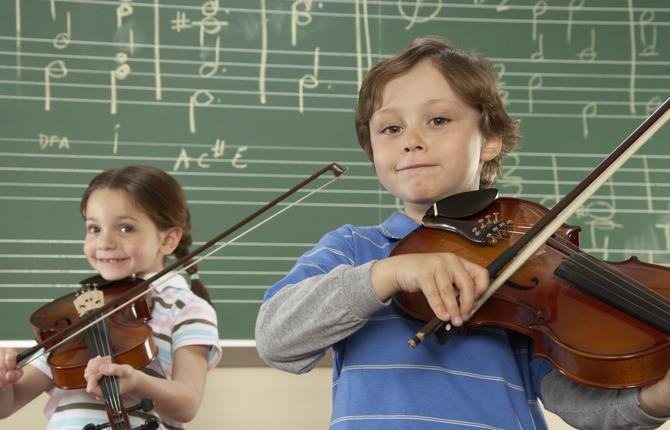
Music education tunes in both sides of the brain
By Melanie Cummings
There’s more reason to take up a musical instrument than fulfilling your rock and roll dreams or being the centre of attention at a party.
While credited for its creative influence on a child’s developing brain, music also benefits the left side of our noggins, the linear and analytical side, reams of research reveals.
“Music is one of the few activities that stimulates both sides of the brain,” states author and educator Linda Verlee Williams in Teaching For the Two-Sided Mind: A Guide to Right Brain/Left Brain Education.
In an October 2010 Scientific American article entitled Hearing the Music, Honing the Mind, neuroscientists reported that studying music makes you smarter.
Through regular lessons and practice at an early age developing brains stay better focused in all subjects from literature to calculus and improve memory and concentration throughout one’s life.
So why is funding for music in Ontario schools at an all time low?
A study by provincial advocacy group People for Education found that only 44 per cent of elementary schools this year have a specialist music teacher — the lowest level since 2005 and far from a peak of 58 per cent in the late 1990s.
That so-called high point is likely the result of a push by the Royal Conservatory of Music. In response to a similar disturbing lack of music and arts programming in schools at the time, the music institution launched a Learning Through the Arts program in 1994, which through innovative tools brought music and arts to subjects such as math, science and literacy.
Angela Elster, vice-president academics at the Royal Conservatory of Music, states in this year’s 125th anniversary video, entitled Strengthening Canadian Society, that, “Early music learning helps build self-confidence, intelligence, cognitive skills intelligence, emotional skills.”
Certainly Prime Minister Stephen Harper credits studying and playing music for giving him focus and confidence, Dr. Peter Simon, president of the Royal Conservatory of Music relates in the anniversary video. Five million Canadians who have participated in the conservatory programs over its 125-year existence can lay claim to such benefits too, including accomplished artists Bruce Cockburn, Paul Schaffer, Gordon Lightfoot Sara McLaughlin, Norman Jewison, Kim Kattral and Ryan Reynolds, to name a few former Conservatory students.
“Music and the arts are the most sublime form of expression that our minds can conceive and produce such exquisite beauty that literally elevates our life,” said Simon.
Studies by Laurel Trainor, the founding director of the Institute of Music and the Mind at McMaster University in Ontario, have shown that improved cognitive function, increased language development, and positive social interaction are all linked to music education.
That is certainly the case with Darren Flower of Rock It Up! who began playing piano at age five, took to the stage at eight and wrote his first song at age 12. He opened what he calls a ‘Music Fun School’ based in Mississauga in 2011. He says disguising learning in music is a clever way to generate interest in students. His approach to teaching is a creative one. Through guitar and bass lessons the former guitarist in the band Stone River encourages students young and mature to experiment with their own writing.
“It makes the experience far more personal and ignites their vivid imaginations,” said Flowers. “Everyone thinks writing songs is difficult but it’s really not.”
And while he says he can’t teach creativity he can “open the floodgates to it at any age.”
Indeed, it is never too late to take up an instrument, according to the Yamaha Music Education System, which believes everyone, from small children to adults, can learn to play music. The global system with more than six million graduates since its creation in 1954 currently has more than 680,000 students in 5,400 locations around the world.
Yamaha focuses on timely education, a method of teaching in which students are guided according to their mental and physical development, says Stephen Couldridge, National Manager of the Music Education Dept., at Yamaha Canada Music LTD in Toronto.Children learn to enjoy music as toddlers and progress to performance in later years. It is the foundational years between four and six when children’s hearing develops rapidly. At this time in a child’s life, Yamaha focuses on learning rhythm, melody and harmony by listening, singing and playing. After age six, when children have better hand co-ordination and cognitive function they are introduced to musical instruction in performance and expression.
“Active music making, especially between the ages of three and six hard-wires the brain to perform better, improving spatial IQ,” said Couldridge. “At Yamaha, through a carefully designed curriculum, we utilize the development of fundamental music skills to encourage creativity and music composition. Creative thought – through music or otherwise – we be increasingly important as the current generation of young people cope with our ever-changing world.”
Whichever method parents decide for their children’s music lessons, know that it will benefit their brains for the long term, according to a study by neuropsychologist Brenda Hanna-Pladdy. Her study, published in April 2011, compared participants aged 60 to 83 who had either no musical training, one to nine years, or 10 or more. The high-level musicians who had studied the longest performed the best on cognitive tests including verbal skills and memory, followed by the low-level musicians and non-musicians, revealing a trend relating to years of musical practice. ?





